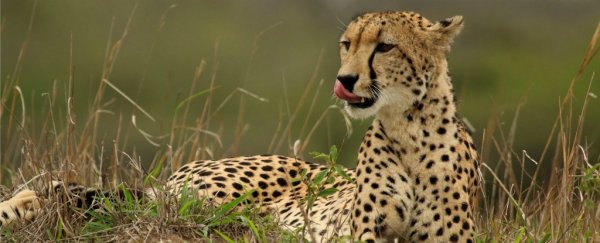Global cheetah (Acinonyx jubatus) populations have crashed, putting the world's fastest land animal on the brink of extinction, according to an international team of researchers.
The team found that a mere 7,100 cheetah are left in the wild, with the species being driven out of 91 percent of its historic habitat. Populations in Asia have suffered the most, leaving only a small pocket of 50 cheetahs left in Iran, while the majority of the global population is now spread across six countries in southern Africa.
"Our findings show that the large space requirements for cheetah, coupled with the complex range of threats faced by the species in the wild, mean that it is likely to be much more vulnerable to extinction than was previously thought," said lead author Sarah Durant from the Zoological Society of London (ZSL).
The team, led by researchers from the Zoological Society of London (ZSL), the Wildlife Conservation Society (WCS), and big cat research organisation Panthera, says the animals will face extinction if further conservation efforts are not taken.
It's hoped that their study will prompt the International Union for Conservation of Nature (IUCN) to upgrade the cheetah conservation status from "vulnerable" to "endangered".
"This study represents the most comprehensive analysis of cheetah status to date," said Durant.
"Given the secretive nature of this elusive cat, it has been difficult to gather hard information on the species, leading to its plight being overlooked."
What makes cheetah so hard to protect is its range - being the fastest land animal, cheetahs maintain a very wide range for hunting prey.
According to the team, roughly 77 percent of a cheetah's habitat would be outside the world's protected zones, making it difficult to keep them safe from poachers and other dangers.
It also makes it a lot harder to monitor how well the species is doing. With such a large range, population studies have been few and far between, which is why the dramatic population decline is only just coming to light.
This problem is further compounded by the fact that human pressures have also led to a steep decline in cheetah prey. The researchers say that's how Zimbabwe's cheetah population dropped from 1,200 animals to just 170 over the course of 16 years - an 85 percent loss.
"In many areas, there's overhunting, which leads to a loss of prey - and if there's no prey, there can be no cheetah," Durant told Ed Yong at The Atlantic.
"If there are no alternatives, cheetah occasionally take livestock, leading to retaliation. There's a live trade in cheetah in the Horn of Africa, with captive animals heading towards the Gulf States."
So, how did the team come up with these figures?
They started by gathering existing data from protected parks and other areas around the world. This data is incomplete because it's only from protected areas - and cheetahs typically extend much further than these reserves - so the team also analysed data from unprotected regions.
With this information, they pieced together how the species' population has changed over the years, finding that cheetahs now only live in just 9 percent of their historical habitats.
One of the most abundant cheetah zones stretches through six countries in southern Africa, with nearly half of the world's population - about 4,000 adults and adolescents.
The rest, reports Yong, are found in small pockets around the world, such as one in Iran, where there are just 50 individuals in total.
The team also developed a computer model, which estimated that if the world's population of cheetah declined by 10 percent per year, over 50 percent of the total cheetah population would likely be gone by 15 years.
Based on these findings, the team is calling for action, asking governments and the IUCN to up the status of the species from "vulnerable" to "endangered" to allow for more comprehensive conservation efforts.
"We've just hit the reset button in our understanding of how close cheetahs are to extinction. The takeaway from this pinnacle study is that securing protected areas alone is not enough," said Kim Young-Overton from Panthera.
"We must think bigger, conserving across the mosaic of protected and unprotected landscapes that these far-ranging cats inhabit, if we are to avert the otherwise certain loss of the cheetah forever."
The team notes that their methods will allow for the study of other threatened species that have been overlooked because of their long range, such as African wild dogs.
Hopefully, the new report will help spur more rigorous conservation efforts for cheetahs before we lose even more of the dwindling population, but only time will tell.
The research was published in Proceedings of the National Academy of Sciences.
